To be able to reach space, we need rockets. Rocket engines work by action and reaction (“To every action, there is always opposed an equal reaction”, see notes 1) and push rockets forward simply by expelling their exhaust in the opposite direction at high speed and can, therefore, work in the vacuum of space. Space rockets are usually enormous in size because the bigger the rocket is, the more thrust can be produced by its engine and can carry more weight into orbit. Here are the top 10 tallest rockets ever launched in the history of space exploration.
List of the tallest rockets ever launched [as of January 2025]
10. Energia: 58.765 meters [192.80 feet]
- Height: 62.50 meters (205.5 feet)
- Diameter: 17.65 meters (57.9 feet)
- Mass: 2,400,000 kg (5,300,000 lb)
- Payload to LEO: 100,000 kg (220,000 lb)
- Payload to GTO (see notes 3): 20,000 kg (44,000 lb)
- Max. Thrust at sea level: 29,000 kN (6,500,000 lbf)
- Max. Thrust in vacuum: 32,000 kN (7,200,000 lbf)
- First flight: May 15, 1987
- Last flight: November 15, 1988
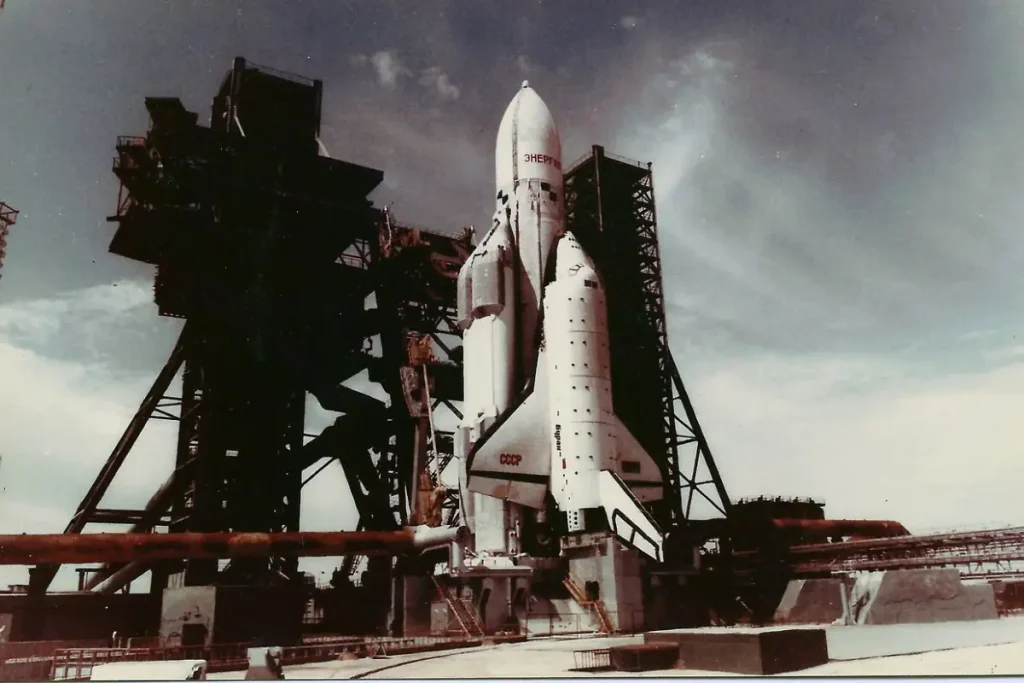
Energia was a super-heavy rocket built by the Soviet Union in the 1980s as part of the Buran program (Soviet counterpart of the Space Shuttle). It has flown into space just twice (May 15, 1987, and November 15, 1988).
Maybe not the tallest rocket ever launched, but Energia was a beast for sure. It was the 4th most powerful rocket (after N1, Saturn V, and Space Shuttle) launched ever. If we discount the unsuccessful N1 rocket, it was the third most powerful rocket ever.
9. Delta IV Medium: 62.50 meters [205.5 feet]
- Height: 62.50 meters (205.5 feet)
- Diameter: 5 meters (16 feet)
- Mass: 404,600 kg (891,990 lb)
- Payload to LEO: 13,774 kg (30,300 lb)
- Payload to GTO (see notes 3): 6,150 kg (13,558 lb)
- Max. Thrust: 3,560 kN (800,000 lbf)
- First flight: November 20, 2002
- Last flight: August 22, 2019
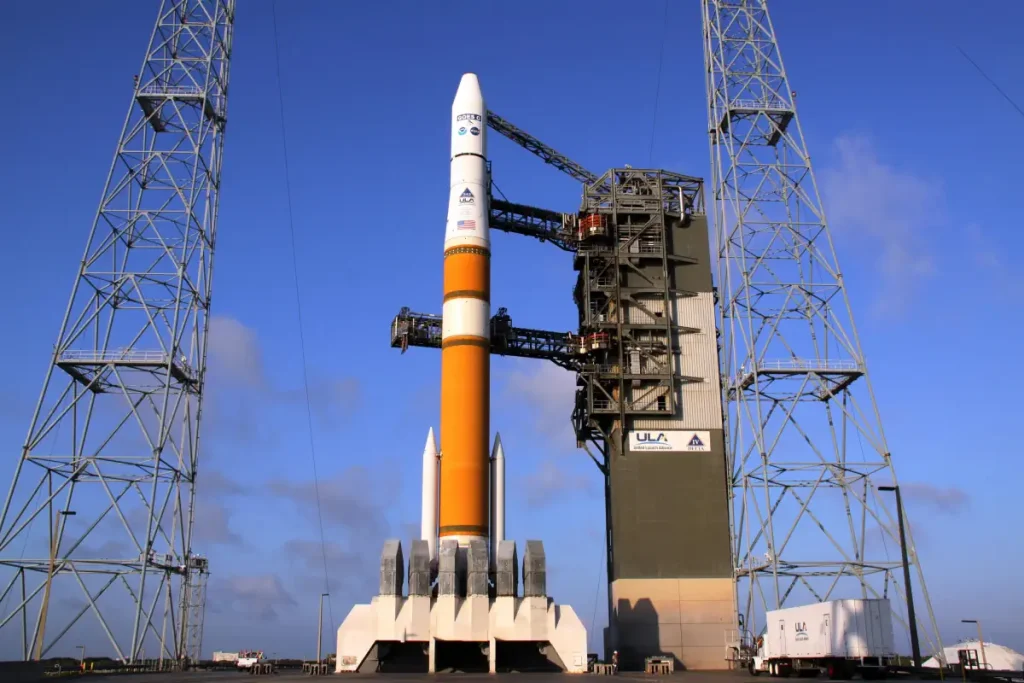
The Delta IV is an expendable launch system. It is primarily designed to satisfy the needs of the U.S. military. It was built by Boeing and operated by the United Launch Alliance for commercial launches, military missions, and NASA flights.
Delta IV uses rockets designed by Boeing’s Integrated Defense Systems division and built in the United Launch Alliance (ULA) facility in Decatur, Alabama.
8. Angara-A5: 64 meters [210 feet]
- Height: 64 meters (210 feet)
- Diameter: 8.86 meters (29.1 feet)
- Mass: 790,000 kg (1,740,000 lb)
- Payload to LEO: 24,500 kg (54,000 lb)
- Payload to GTO (see notes 3): 7,500 kg (16,500 lb)
- Max. Thrust: 7,680 kN (1,730,000 lbf)
- First flight: December 25, 2014
- Last flight: December 27, 2021

The Angara-A5 heavy-lift launch vehicle is the second rocket developed in the Russian-made Angara rocket family. Angara rockets are intended, along with Soyuz-2 variants, to replace several existing launch vehicles.
7. Falcon Heavy: 70 meters [230 feet]
- Height: 70 meters (230 feet)
- Diameter: 3.66 meters (12.0 feet)
- Width: 12.2 meters (40 feet)
- Mass: 1,420,788 kg (3,132,301 lb)
- Payload to LEO: 63,800 kg (140,700 lb)
- Payload to GTO (see notes 3): 26,700 kg (58,900 lb)
- Payload to Mars: 16,800 kg (37,000 lb)
- Payload to Pluto: 3,500 kg (7,700 lb)
- Max. Thrust: Sea level: 15,200 kN (3,400,000 lbf), Vacuum: 16,400 kN (3,700,000 lbf)
- First flight: February 6, 2018
- Last flight: June 25, 2019
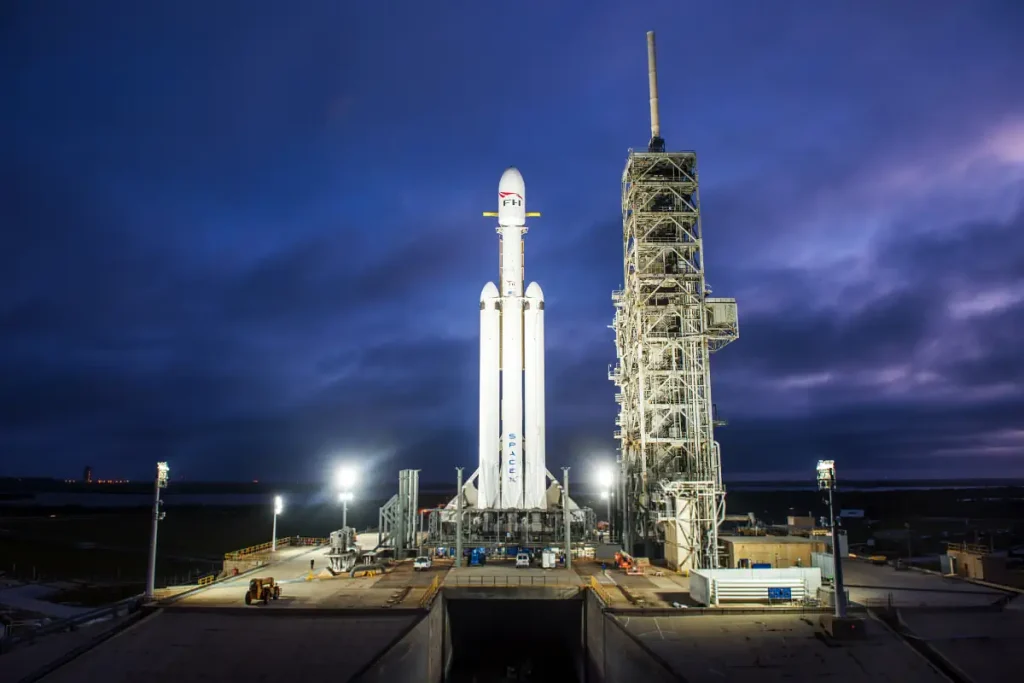
As of 2022, Falcon Heavy is the world’s most powerful operational rocket. Designed and manufactured by SpaceX, it is a partially reusable heavy-lift launch vehicle.
SpaceX conducted Falcon Heavy’s first test flight on February 6, 2018, at 3:45 p.m. EST (20:45 UTC). The rocket carried a Tesla Roadster belonging to SpaceX founder Elon Musk as a dummy payload.
Falcon Heavy was designed to carry humans into space beyond low Earth orbit, especially to the Moon, Mars, and potentially to asteroids for mining. But Elon Musk, the founder and the CEO of SpaceX, does not plan to apply for a human-rating certification to carry NASA astronauts. By the early 2020s, the BFR (“Big Falcon Rocket”) will replace the Falcon Heavy and other current Falcon launch vehicles.
6. Delta IV Heavy: 72 meters [236 feet]
- Height: 72 meters (236 feet)
- Diameter: 5 meters (16 feet)
- Width: 15 meters (49 feet)
- Mass: 733,000 kg (1,616,000 lb)
- Payload to LEO: 28,790 kg (63,470 lb)
- Payload to GTO (see notes 3): 14,220 kg (31,350 lb)
- Max. Thrust: 6,280 kN (1,410,000 lbf)
- First flight: December 21, 2004
- Last flight: September 24, 2022

First launched in 2004, the Delta IV Heavy (Delta 9250H) is an expendable heavy-lift launch vehicle. It is the largest type of the Delta IV rocket family and is the world’s fourth-highest-capacity rocket in operation, with a payload capacity half of SpaceX’s Falcon Heavy rocket. It is manufactured by United Launch Alliance.
5. Ares I-X: 94.2 meters [309 feet]
- Height: 94.2 meters (309 feet)
- Diameter: 5.5 meters (18 feet)
- Payload to LEO: 25,400 kg (56,000 lb)
- Max. Thrust: 15,000 kN (3,372,134 lbf)
- First (and only) launch: October 28, 2009

The now-canceled Ares I was the crew launch vehicle that was being developed by NASA as part of the Constellation program. Ares I-X was the first-stage prototype of Ares-I. It was launched on October 28, 2009.
Ares I rockets were intended to launch Orion crew exploration vehicles. But, now NASA is developing the Space Launch System (SLS) to launch the Orion spacecraft.
4. Artemis and New Glenn: 98 meters [322 feet]
Artemis [NASA]
- Height: 98 meters (322 feet)
- Diameter: 8.4 meters (27.6 feet)
- Width: 15 meters (49 feet)
- Mass: 2,750,000 kg (6,060,000 lb)
- Payload to LEO: 95,000 kg (209,000 lb)
- Max. Thrust: 39,144 kN (8,800,000 lbf)
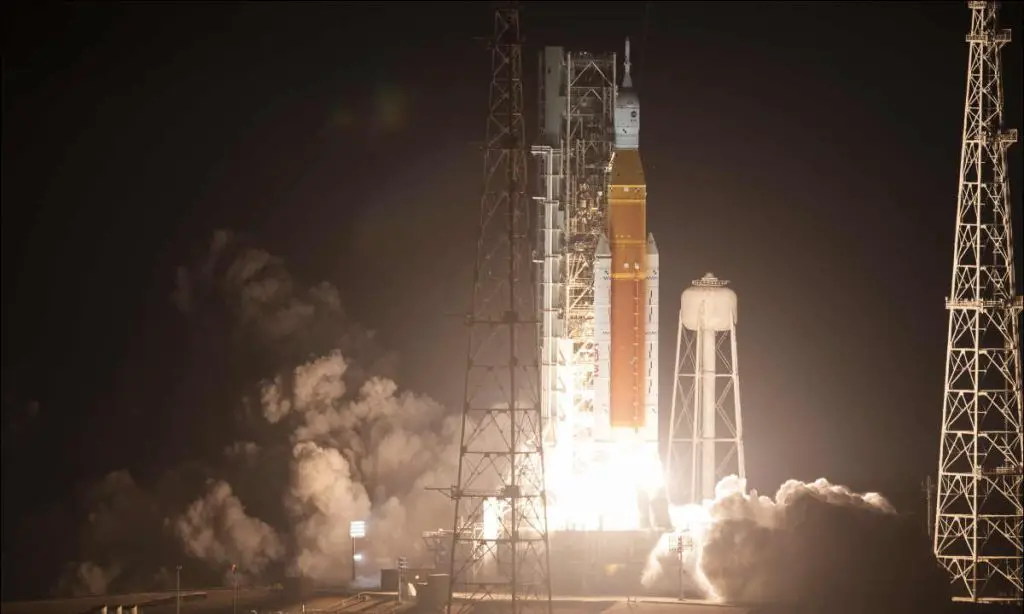
Artemis I was launched on November 16, 2022, from Launch Complex 39B at Kennedy Space Center. After reaching Earth orbit, the upper stage carrying the Orion spacecraft performed a trans-lunar injection, releasing Orion and deploying ten CubeSat satellites. Orion conducted a flyby of the Moon on November 21, entered a distant retrograde orbit for six days, and completed a second lunar flyby on December 5.
On December 11, the Orion spacecraft returned to Earth, reentering the atmosphere protected by its heat shield before splashing down in the Pacific Ocean. This uncrewed mission was designed to certify the Orion spacecraft and the Space Launch System (SLS) for crewed missions. The next step, Artemis II, is scheduled for no later than April 2026 and will involve a crewed lunar flyby. Following that, Artemis III will achieve a historic milestone with a crewed lunar landing, the first since Apollo 17 in 1972.
New Glenn [Blue Origin]
- Height: 98 meters (322 feet)
- Diameter: 7 meters (23 feet)
- Payload to LEO: 45,000 kg (99,000 lb)
- Payload to GTO (see notes 3): 13,600 kg (30,000 lb)
- Payload to TLI (See notes 4): 7,000 kg (30,000 lb)
- Max. Thrust: 17,100 kN (3,850,000 lbf)
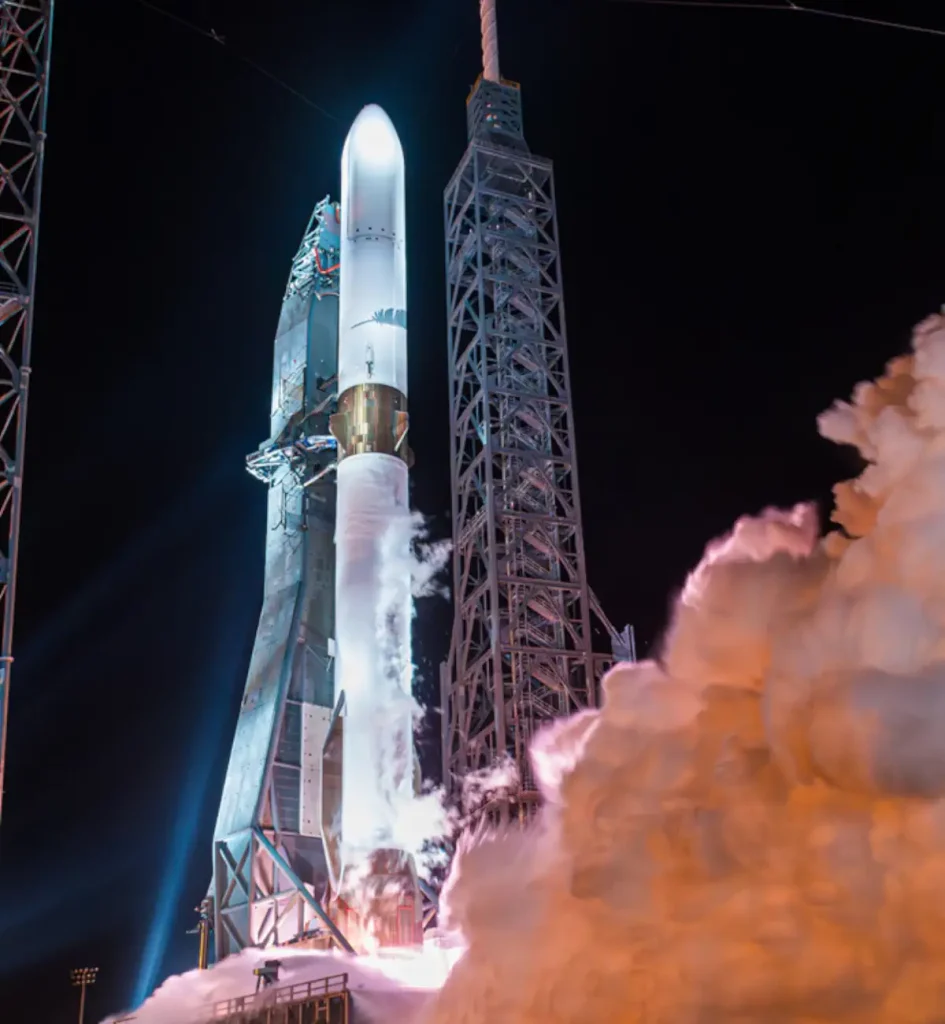
New Glenn is a heavy-lift rocket developed by the American aerospace company Blue Origin. It features a two-stage, partially reusable design with a 7-meter (23 feet) diameter. The rocket’s first stage is powered by seven BE-4 engines, while its second stage uses two BE-3U engines, all developed in-house by Blue Origin. Launch operations are conducted from Cape Canaveral’s Launch Complex 36, with additional missions planned from Vandenberg Space Launch Complex 9.
Development of New Glenn began before 2013 and was officially revealed in 2016. The rocket is named after John Glenn, the first American astronaut to orbit Earth. The inaugural vehicle was unveiled on the launch pad in February 2024, with its maiden flight occurring on January 16, 2025. This flight carried a prototype Blue Ring spacecraft and marks the first in a series of demonstration launches required for certification under the National Security Space Launch program.
New Glenn successfully reached Earth orbit on its maiden flight, marking a significant milestone for Blue Origin.
Much like Blue Origin’s suborbital New Shepard rocket, designed for space tourism, New Glenn’s first stage is reusable and lands on a barge called Landing Platform Vessel 1. In 2021, the company also launched Project Jarvis, an initiative to develop a reusable second stage, further advancing New Glenn’s sustainability and cost-efficiency.
3. N1: 105 meters [344 feet]
- Height: 105 meters (344 feet)
- Diameter: 17.0 meters (55.8 feet)
- Width: 15 meters (49 feet)
- Mass: 2,750,000 kg (6,060,000 lb)
- Payload to LEO: 95,000 kg (209,000 lb)
- Payload to TLI (See notes 4): 23,500 kg (51,800 lb)
- Max. Thrust: 45,400 kN (10,200,000 lbf)
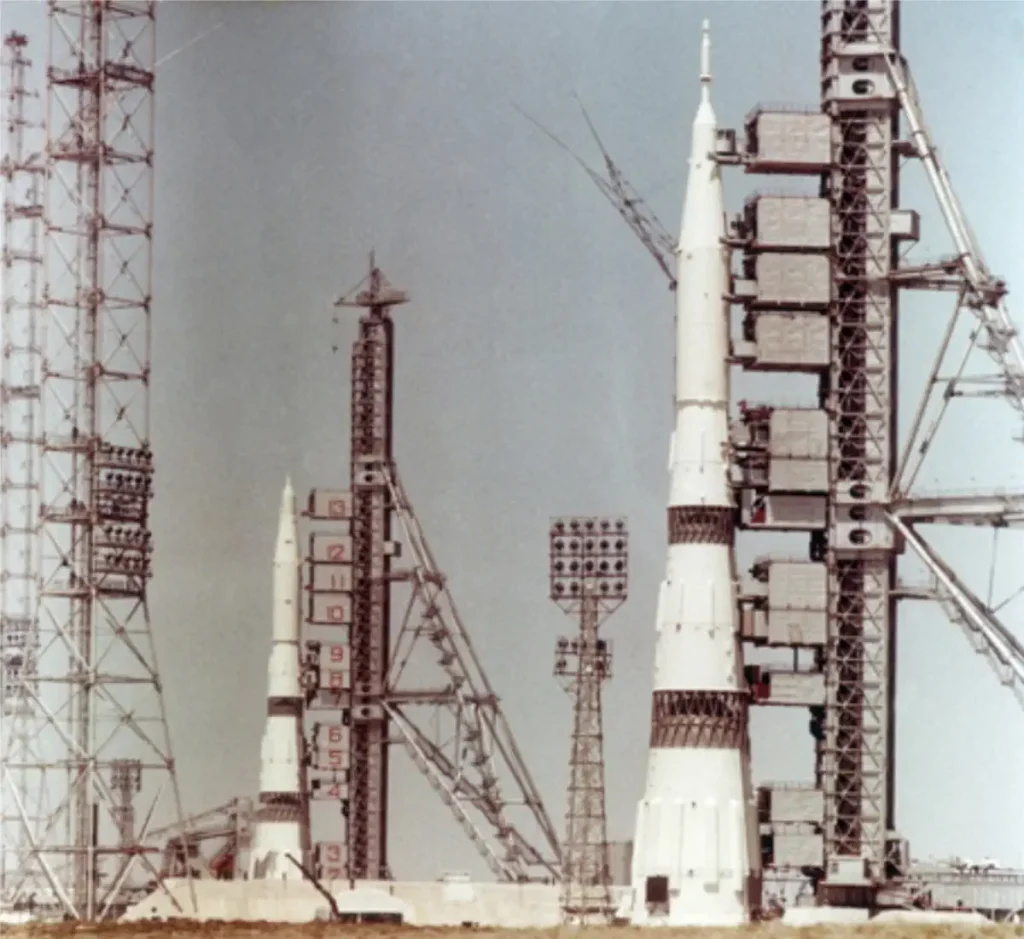
N1 was the Soviet counterpart to NASA’s moon rocket, Saturn V. It was designed with crewed extra-orbital travel in mind (i.e. moon landing). Its first stage still remains the most powerful rocket stage ever built. However, the development of the rocket was underfunded and rushed.
N1’s development started in October 1965, almost four years after the United States’ Saturn V. The project was badly derailed by the death of its chief designer Sergei Korolev (1907 – 14 January 1966, the lead Soviet rocket engineer and spacecraft designer during the Space Race) in 1966.
Each of the four attempts to launch an N1 failed. During the second launch attempt, the N1 rocket crashed back onto its launch pad shortly after liftoff and exploded, resulting in one of the largest artificial non-nuclear explosions in human history.
The N1 program was suspended in 1974 and was officially canceled in 1976. Along with the rest of the Soviet crewed lunar programs, the N1 was kept secret almost until the collapse of the Soviet Union in December 1991. Information about the N1 was first published in 1989.
2. Saturn V: 110.6 meters [363 feet]
- Height: 110.6 meters (363 feet)
- Diameter: 10.1 meters (33 feet)
- Width: 15 meters (49 feet)
- Mass: 2,970,000 kg (6,540,000 lb)
- Payload to LEO: 140,000 kg (310,000 lb)
- Payload to TLI: 48,600 kg (107,100 lb)
- Max. Thrust: 35,100 kN (7,891,000 lbf)
- First flight: November 9, 1967 (Apollo 4)
- Last flight: May 14, 1973 (Skylab)

Related: Saturn V Rocket [Documentary]
The Saturn V was an American human-rated expendable rocket used by NASA between 1967 and 1973. The three-stage liquid-fueled super heavy-lift launch vehicle was developed to support the Apollo program for human exploration of the Moon and was later used to launch Skylab, the first American space station.
The Saturn V was launched 13 times from the Kennedy Space Center in Florida with no loss of crew or payload.

Watch the liftoff of the mighty Saturn V rocket:
1. SpaceX Starship: 120 meters [394 feet]
- Height: 110.6 meters (363 feet)
- Diameter: 9 meters (30 feet)
- Mass: 5,000,000 kg (11,000,000 lb)
- Payload to LEO: 150,000 kg (330,693 lb)
- Max. Thrust: 74,500 kN (16,700,000 lbf)
- First flight: April 20, 2023 (failed)
SpaceX is developing Starship, a super heavy-lift space launch vehicle. With a height of 120 meters (394 feet) and a liftoff mass of 5,000 metric tons (Block 1 variant), Starship is the largest and most powerful reusable launch vehicle ever built.
It was first launched on April 20, 2023, but the first test was a failure. The rocket lost several engines after the launch, and the vehicle reached a maximum altitude of 39 km (24 miles). The spacecraft was unable to separate from the booster and the rocket was intentionally destroyed by commanding the flight termination system.
As of December 2024, Starship vehicles have been launched six times for flight tests over two years, resulting in four successes (66.67%), and two failures. Starship Block 1 has been launched six times between April 2023 to November 2024, with the ship being retired ahead of the seventh flight. Block 1 boosters are expected to fly further into the future.
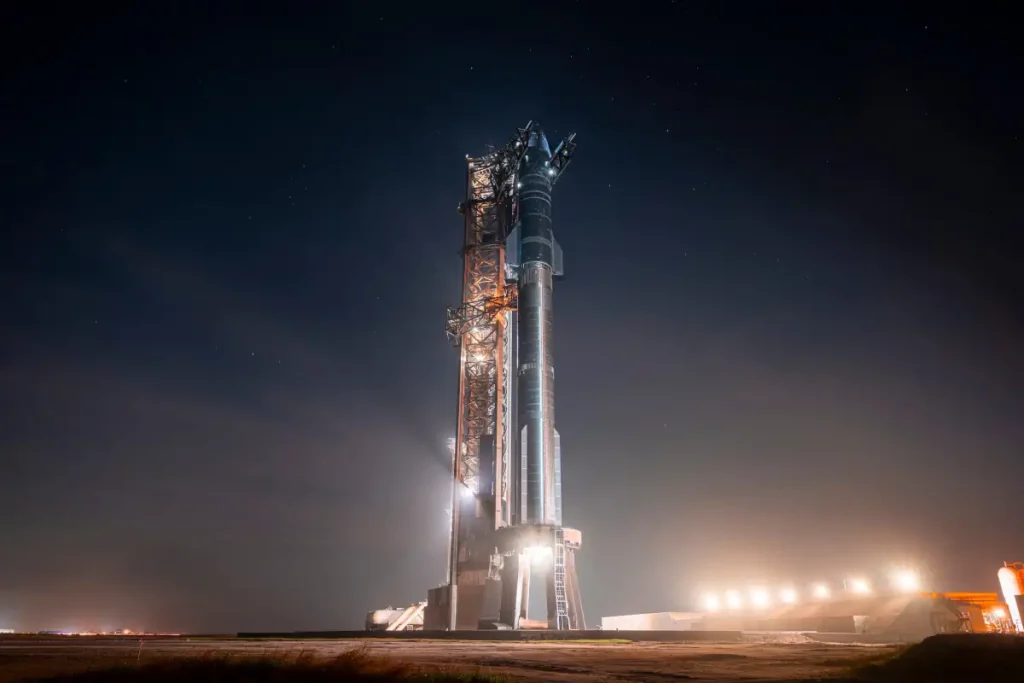
Watch: how big SpaceX rockets really are
Visual Effects Youtuber “Corridor Crew” (see his YouTube channel) put together a video that shows off SpaceX’s rockets (Falcon 9, Falcon Heavy, and BFR) in real-life situations.
Top 12 tallest rockets ever launched, sorted by the Max. thrust
- SpaceX Starship: 74,500 kN (16,700,000 lbf)
- N1: 45,400 kN (10,200,000 lbf)
- Artemis: 39,144 kN (8,800,000 lbf)
- Saturn V: 35,100 kN (7,891,000 lbf)
- Space Shuttle: 35,000 kN (7,800,000 lbf) *
- Energia: 32,000 kN (7,200,000 lbf)
- Falcon Heavy: Sea level: 15,200 kN (3,400,000 lbf), Vacuum: 16,400 kN (3,700,000 lbf)
- Ares I-X: 15,000 kN (3,372,134 lbf)
- Ariane 4: 12,120 kN (2,725,000 lbf)
- Atlas V: 10,600 kN (2,400,000 lbf)
- Angara-A5: 7,680 kN (1,730,000 lbf)
- Delta IV Heavy: 6,280 kN (1,410,000 lbf)
- Delta IV Medium: 3,560 kN (800,000 lbf)
Top 12 tallest rockets ever launched, sorted by the payload capacity to LEO
- SpaceX Starship: 150,000 kg (330,693 lb)
- Saturn V: 140,000 kg (310,000 lb)
- Energia: 100,000 kg (220,000 lb)
- Artemis: 95,000 kg (209,000 lb)
- N1: 95,000 kg (209,000 lb)
- Falcon Heavy: 63,800 kg (140,700 lb)
- Delta IV Heavy: 28,790 kg (63,470 lb)
- Space Shuttle: 27,500 kg (60,600 lb) *
- Ares I-X: 25,400 kg (56,000 lb)
- Angara-A5: 24,500 kg (54,000 lb)
- Delta IV Medium: 13,774 kg (30,300 lb)
- Atlas V: 8,250-20,520 kg (18,190-45,240 lb)
- Ariane 4: 5,000-7,600 kg (11,024-16,756 lb)
(*) The space shuttle is not in the top 12 tallest rockets list.
Notes
- Newton’s third law: When one body exerts a force on a second body, the second body simultaneously exerts a force equal in magnitude and opposite in direction on the first body.
- Low Earth orbit (LEO) is an orbit around Earth with an altitude between 160 kilometers (99 mi) (orbital period of about 88 minutes), and 2,000 kilometers (1,200 mi) (orbital period of about 127 minutes).
- A geostationary orbit, geostationary Earth orbit, or geosynchronous equatorial orbit (GEO) is a circular orbit 35,786 kilometers (22,236 mi) above the Earth’s equator and following the direction of the Earth’s rotation. An object in such an orbit has an orbital period equal to the Earth’s rotational period (one sidereal day) and thus appears motionless, at a fixed position in the sky, to ground observers.
- A trans-lunar injection (TLI) is a propulsive maneuver used to set a spacecraft on a trajectory that will cause it to arrive at the Moon.
Sources
- “The World’s Tallest Rockets: How They Stack Up” on Space.com
- How The World’s Tallest Rockets Stack Up on the “Born to Engineer” website
- Rocket on Wikipedia
- Reaction (physics) on Wikipedia
- Newton’s laws of motion on Wikipedia
- Space Shuttle on Wikipedia
- Space Shuttle Basics on NASA.gov
- Atlas V on Wikipedia
- Atlas V on ULA (United Launch Alliance) Website
- Ariane 4 on Wikipedia
- Delta IV Medium+ (5,4) on the SpaceFlight 101 website
- Angara rocket family on Wikipedia
- Falcon Heavy on Wikipedia
- Falcon Heavy on SpaceX website
- Delta IV Heavy on Wikipedia
- N1 Rocket on Wikipedia
- Saturn V on Wikipedia
- New Glenn Rocket on the Blue Origin’s website
- How Many Elephants are Left in the World in 2025? - August 17, 2025
- Moon Landings: All-Time List [1966-2025] - February 2, 2025
- What Is Max-Q and Why Is It Important During Rocket Launches? - January 16, 2025
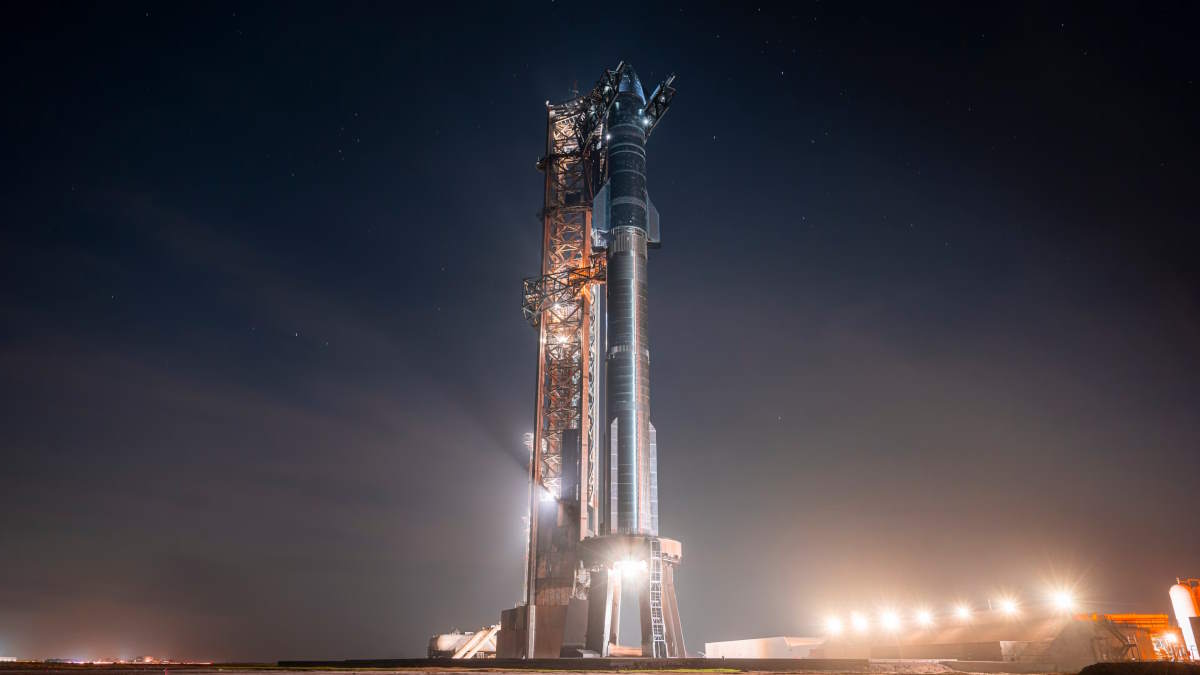

One reply on “Top 10 Tallest Rockets Ever Launched [2025 Update]”
And where is soviet “ENERGIYA” semi-reusable super-heavy launch vehicle (rocket), which was a part of the super-heavy lift launch (rocket + multi-flight orbital plane) system “ENERGIYA-BURAN” super-heavy launch rocket system, which was flgiht twice (first – in May 15, 1987 with the “Polyus”/”Skif-DM” special satellite system prototype, and second – in November 15, 1988 with the “Buran” heavy orbital plane)?
“Energiya” super-heavy rocket payload capacity was up to 100,000 kg (220,462 lb) to LEO or 20,000 kg (44,000 lb) to GSO; max. thrust was up to 34,800 kN (7,800,000 lbf) at the sea level or up to 39,500 kN (8,900,000 lbf) in vacuum; and total hieght was 58.765 m (192.80 ft).
You can see more details about this rocket system here: https://en.wikipedia.org/wiki/Energia